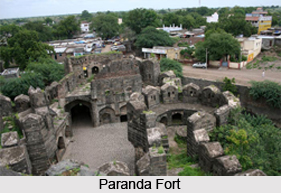 The Paranda Fort was built in the mid-fifteenth century by one of the Bahmani Kings of the Deccan. It is located on a level plain about 18 miles West of Barsi town in the Osmana district of Maharashtra. The fort, one of the many erected by the Bahmani kings, is a fine example of military architectural and engineering expertise.
The Paranda Fort was built in the mid-fifteenth century by one of the Bahmani Kings of the Deccan. It is located on a level plain about 18 miles West of Barsi town in the Osmana district of Maharashtra. The fort, one of the many erected by the Bahmani kings, is a fine example of military architectural and engineering expertise.
The Paranda Fort is a small but interesting rectangular fort, defended by a double line of powerful curtain walls with formidable corner bastions surrounded by a wide, deep ditch. This moat was always kept filled with water. A total of twenty six bastions are found inside the fort. Among the notable ones are the Mahakal Buruj, the Chanchal buruj, the Buland Buruj etc. Some of them are found still harbouring old guns, like the Malik e Maidan and the Asda Paikar. The curtain walls run parallel with each other but are separated by a wide space commanded by the inner wall, the bastions of which rise high over the outer wall. The battlements of both walls are reinforced at intervals with machicolations.
The original form can be traced quite clearly as it survives largely complete. There is only one entrance to the fort, midway along the north side, with separate gateways in each wall in staggered succession. The outer gateways project into the perimeter ditch. Originally, this was approached over a drawbridge defended by a heavy iron chain, which in emergencies could be drawn across the front of the door and secured on both sides. The robust teak door was clad in iron plates and secured by a huge timber bar. The customary right-angled turn in the vaulted entrance could be commanded by guards posted to the left. Loopholes to the north and west cover the approaches and the ditch.
There is an unusual hinge adjacent to the door into the court. At the far end of the court a third gateway, reinforced with anti-elephant spikes, opens into the space between the walls. The gateway through the second wall is protected by a barbican, bastions and a balcony projecting from the inner wall high over the barbican. The passageway is also well defended.
Inside the fort are a mosque, built after the Muslim occupation, the ruins of the Narsimha Mandir, the ruins of a palace in the north-west and a large well. Remains of buildings like the Baradari Taikhana, Zenana Makan etc are also to be found here. To the east the ground rises sharply up to the wall-walk of the inner curtain, facilitating rapid access to the defences in times of attack.
The Paranda Fort has not seen any battles during the entire course of its existence. It was used as a storage department for canons and other weapons, and some of those can be seen lying there even today. In 1630 Shahjahan was repulsed from here, but twenty years later Aurangzeb succeeded in capturing it during his viceroyalty of the Deccan.



















